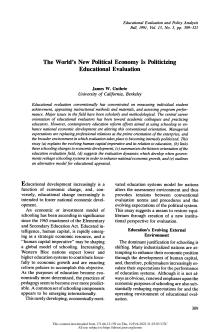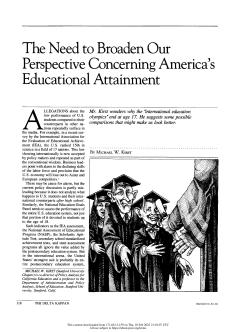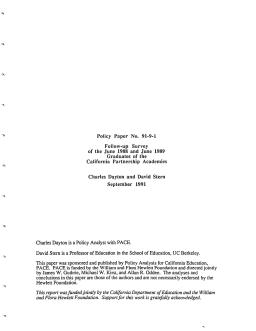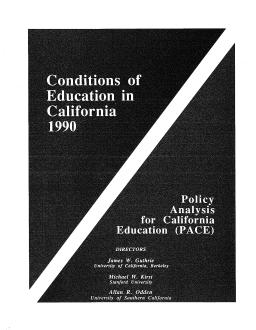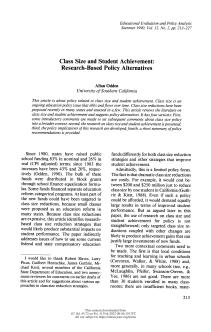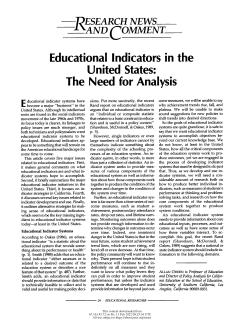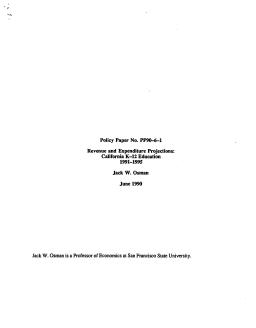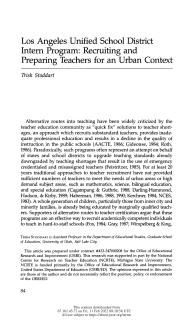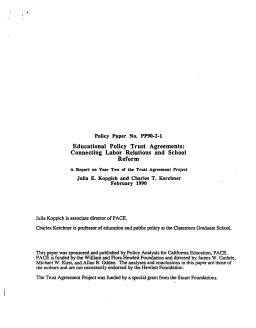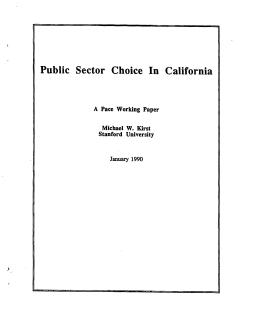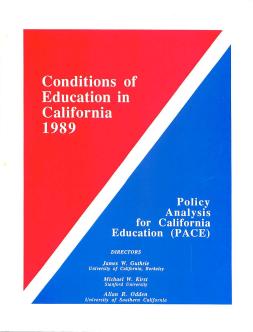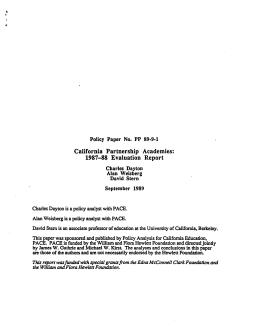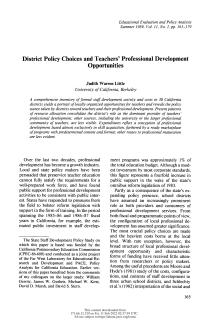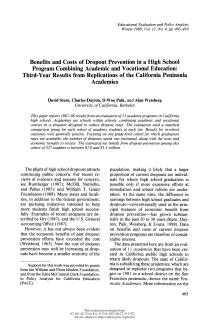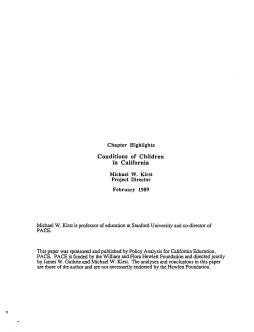Recruiting and Preparing Teachers for an Urban Context
Published
Summary
Traditional teacher recruitment fails to meet urban area and high-demand subject needs. Alternative certification programs offer a solution but are criticized for being a "quick fix". The LAUSD Intern Program case study addresses questions on effectiveness and preparation of alternative-certified teachers. On-the-job training is context-specific and not a replacement for college-based education.
Published
Summary
Traditionally, educational evaluation has focused on measuring student achievement and program performance. However, education reforms are now linking schooling to economic development, leading to a shift towards managerial expectations and politicization of the field. This article explains the human capital imperative and its relation to education, summarizes the history of educational evaluation, and outlines an alternative model for educational appraisal in the context of government-led education system reforms aimed at enhancing national economic growth.
Published
Summary
The U.S. ranks low in international education comparisons, but the discussion is misleading because it does not look at postsecondary education. The value added by the postsecondary education system, including community colleges, trade schools, and universities, is ignored. The U.S.'s strongest suit is probably its entire postsecondary education system in the international arena.
California and Senate Bill 813
Published
Summary
In 1983, the California legislature enacted a series of incentive programs intended, in part, to encourage local school districts to devote more resources toward instructional expenditures. Analysis of district response to those incentives shows they were more effective in directing spending toward direct instruction than were general or categorical grants. However, it appears that as the incentive funds were rolled into general aid revenues, district spending patterns began to revert to the same distribution of expenditures observed prior to enactment of the incentives.
Published
Summary
This study compares the post-secondary experiences of graduates from California Partnership Academies with their matched comparison groups. The findings show that Academy graduates are doing equally well as comparison students in the first year or two after graduation, indicating that Academy programs have not achieved higher graduation rates at the expense of lower success rates after high school. However, there may be more subtle differences between the two groups that are not detectable by simple measures.
Published
Summary
CA's education system is affected by external factors like shifting demographics, declining economics, and intensifying politics, limiting the traditional routes of local decision-making and property taxation. Although some districts show excellence and commitment, creating and sustaining a statewide education system to meet 21st-century expectations is difficult without a comprehensive reform plan. Political conflict over revenue earmarking and school reform distracts from education improvement. This report describes and analyzes these issues, suggesting a comprehensive set of solutions.
Overcoming Barriers, Creating New Opportunities
Published
Summary
This article highlights the changing nature of childhood, with increasing physical and mental health problems, substance abuse, child abuse, inadequate child care, and family disorganization. Furthermore, schools struggle to meet the needs of non-middle-class, nonwhite, non-English-speaking children, as more students from these backgrounds enter public schools. To improve educational prospects, school leaders must recognize how children's daily lives affect their education and adapt to these changes.
Research-Based Policy Alternatives
Published
Summary
This article delves into the issue of class size in education, examining how it affects student achievement and suggesting policy alternatives. With some states proposing and implementing class size reductions, the analysis discusses the research on the subject and its policy implications. The piece is divided into four sections, starting with an introduction that provides context for the class size debate.
The Need for Analysis
Published
Summary
Educational indicator systems are in demand in the US due to their strong linkages to policy issues. This article covers five major issues related to educational indicators, including what they are, major initiatives in the US, and indicator strategies in California. It also discusses key issues related to indicator development and use and outlines alternative strategies for making sense of educational indicators, which are currently missing in the US.
California K–12 Education 1991–1995
Published
Summary
This report discusses the importance of forecasting revenues and expenditures for public sector planning and budgeting. It highlights three characteristics of California's recent experience. First, K-12 funding rose 91% from 1980 to 1989, but real revenue growth was tempered by inflation. Second, California relies more on state revenues for K-12 education than the rest of the US. Third, California's "effort" in raising K-12 revenues in 1986 was lower than the US average, and revenue efforts for both schools and other public functions are below the national average.
Recruiting and Preparing Teachers for an Urban Context
Published
Summary
This article discusses the criticism of alternative routes to teaching, which are seen as inadequate and leading to declining instructional quality, but are attempting to address the shortage of qualified teachers in urban and high demand subject areas. Supporters argue that they are effective in recruiting competent teachers for hard-to-staff schools and replacing the emergency credential system with rigorous training. The article highlights the impact of teacher shortages on inner city and minority students who are currently being educated by marginally qualified teachers.
Connecting Labor Relations and School Reform: A Report on Year Two of the Trust Agreement Project
Published
Summary
The Trust Agreement Project, initiated in September 1987, is a joint effort of 12 California school districts and their teachers' unions. It enables teachers and school management to develop agreements on professional issues beyond the traditional scope of collective bargaining. The agreements cover topics like teacher evaluation and curriculum development, and aim to enhance educational capacity by promoting collective responsibility for educational processes and outcomes. The project appears to be altering decision-making processes and encouraging collaboration between unions and management.
A Comparison of Education Reforms in the United States and Great Britain
Published
Summary
The new global economy is reshaping education worldwide, necessitating policies that expand access and enhance quality. Despite different educational systems, similar issues need to be addressed, resulting in an international convergence of education policies. The article discusses the emerging economy, educational challenges, policy alternatives, and compares recent reforms in the US and UK.
Published
Summary
The study examines the Partnership Academies in California, which are designed to reduce high school dropout rates among at-risk students. Academies combine high school curriculum, technical courses, and support from local businesses, with funding based on student outcomes. Survey results indicate that Academy students had a lower dropout rate than comparison group students, were more likely to attend college, and earned higher wages while working and studying. Graduates from both groups reported being fairly satisfied with their high school preparation and achievements since graduation.
A PACE Working Paper
Published
Summary
California saw renewed interest in the issue of education choice in the late 1980s, with 11 bills introduced in the 1989 legislative session. The primary reason for this is the reluctance to consider public aid to private schools. California State Superintendent Bill Honig proposed AB 2134, which would require parents to choose a public school each year. The politics of choice have changed, and low-cost proposals that don't promote alternative school sites have become popular. This paper analyzes the California bills and their implications for education choice in California.
Published
Summary
This is the fifth edition of Conditions of Education in California. Over time, the content and format have changed in keeping with suggestions made by readers. This publication is based upon compilations and syntheses of information collected by other agencies and individuals. These sources are noted throughout the text. We wish here to express our appreciation to these others upon whose efforts we depend so heavily. Also, PACE undertakes a substantial amount of original data collection and analysis. We make specific mention of this throughout the text.
1987–88 Evaluation Report
Published
Summary
This report presents findings from the third annual evaluation of Partnership Academy Programs in CA, a high school-based, state-funded program with a school-within-a-school administrative structure that enrolls at-risk students with academic potential. The program provides students with basic job skills in a promising labor-market field and support from local businesses, including curriculum development, guest speakers, field trips, mentors, and work experience positions. The evaluation addresses the quality of program implementation and the degree to which programs follow the academy model.
Issues and Options for Early Childhood Programs
Published
Summary
The growing demand for compensatory education and for child care has generated a rash of federal legislation; many states have enacted new early childhood programs, most of them located within schooling systems, and many others are considering their options. This article examines the basic policy issues governments confront in early childhood education, including the content of programs, their financing, and the inevitable trade-off between cost and quality. The final section of the article outlines the available policy options.
Published
Summary
An inventory of 30 California districts reveals their policy stance on teacher professional development, which primarily consists of skill acquisition through district-led programs. Other sources, such as universities or professional communities, are less visible. The districts are the dominant providers of development opportunities, with expenditures reflecting a ready marketplace of predetermined programs. Alternative routes to professional growth are less evident.
A Hypothetical Account and Research Review
Published
Summary
This paper discusses childcare quality and its impact on child development. It highlights the need to consider various factors that contribute to quality and how they affect children's experiences. Presented is a hypothetical day in two different childcare situations to demonstrate the varying experiences children have. The characters and incidents are fictional but based on the author's real observations and experiences in early childhood programs in CA. The author emphasizes the need to promote quality early childhood programs informed by research in child development and early education.
Third-Year Results from Replications of the California Peninsula Academies
Published
Summary
Evaluation of 11 California high school academies in 1987-88 found positive in-school outcomes. Academies combine academic and vocational courses to reduce dropout rates. Graduation rates available for one grade-level cohort, with an estimated net benefit of $1.0-1.3 million from dropout prevention.
An Exploration of the Debate on School District Size
Published
Summary
The notion that larger school districts are superior has changed, with some researchers advocating for smaller ones. Recent reform reports have focused on the school site as the decision-making seat. Three main issues guide district size research: fiscal efficiency, school effectiveness, and community identity. Although research has been conducted, there is still no definitive answer. This article explores the research and debate on the "right" size for school districts and identifies unanswered questions, hoping to kindle interest in further research.
Published
Summary
California's growing child population will require significant increases in public spending, particularly in education due to immigration, working parents, poverty, and family disorganization. Counties and school districts bear the brunt of providing children's services, but cities have greater fiscal flexibility and revenue-raising potential. This paper provides information on county children's services and trends in county budgets to support further research on county financing for children's services.
1960 to 1988
Published
Summary
Public school funding in the US has seen continuous increases in real funding since 1960, reflecting strong citizen support for public schools and a growing economy. Despite pessimism and recession in the 1980s, real school funding continued to increase substantially. This report provides an overview of school revenues and funding increases needed for education reforms, and details changes in education finance during the 1980s, comparing increases to the levels needed to fund proposed reforms.
Chapter Highlights
Published
Summary
This report provides social indicators to evaluate the quality of life for children in California, covering physical and mental health, safety, sexual behavior, academic achievement, and the settings and systems that serve children. Despite most children being healthier and better schooled than in the past, recent polls indicate concern about child-rearing and the likelihood of an expanding educational underclass. The report aims to offer a portrait of the quality of California's children, address gaps in available data, and provide limited policy recommendations.

